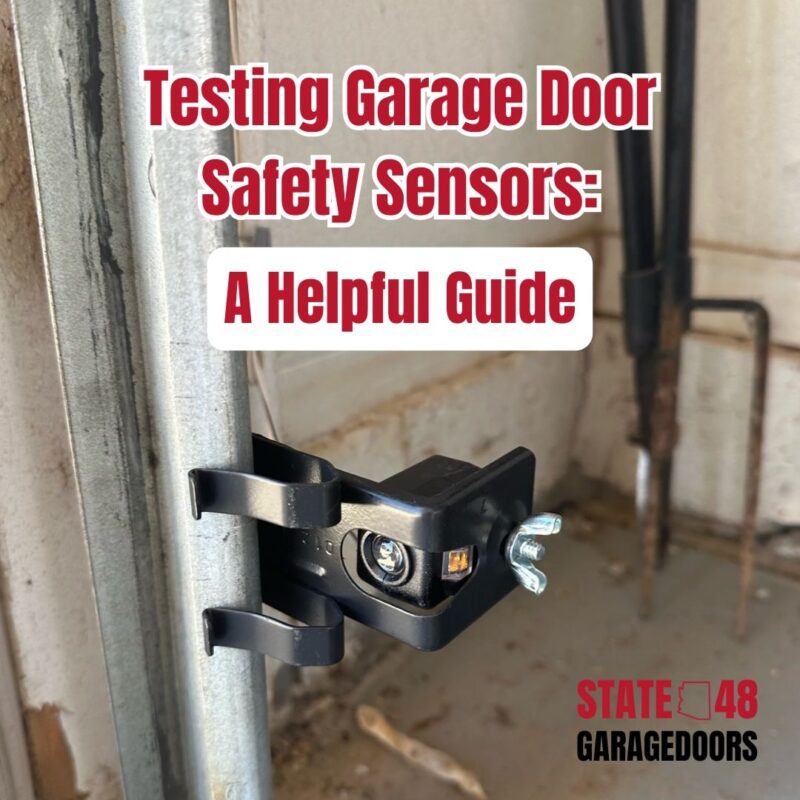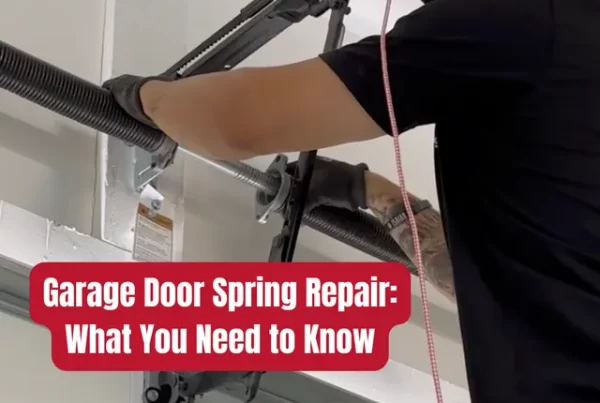
Testing Garage Door Safety Sensors: A Helpful Guide

A Guide on Testing Garage Door Safety Sensors at Home
Have you ever wondered if your garage door safety sensors are working correctly? These small devices play a crucial role in preventing accidents and keeping your family safe. This guide will walk you through the process of testing your garage door safety sensors at home. You’ll learn how to check if they’re functioning properly, troubleshoot common issues, and maintain them for long-term reliability. By following these steps, you can ensure your garage door operates safely and avoid potential hazards.
Understand the Importance of Garage Door Safety Sensors at Home

Your garage door safety sensors play a crucial role in keeping your home secure. They prevent accidents and protect your family and belongings. Let’s explore how these sensors work, the risks of not having them, and their key features. Understanding these aspects will help you maintain a safer garage environment. If you require garage door repair phoenix, contacting a professional can ensure your sensors remain effective.
Recognize How Safety Sensors Keep Your Garage Secure and Safe
Your garage door safety sensors act as vigilant guardians, constantly monitoring the area beneath your door. They use invisible beams to detect any objects or people in the door’s path, instantly stopping and reversing the door if something is detected. This smart system helps prevent accidents, protecting your family, pets, and vehicles from potential harm. By ensuring your garage door won’t close on anything in its way, these sensors provide an essential layer of security and peace of mind for your home.
Learn About the Potential Hazards Without Functional Sensors
Without working safety sensors, your garage door becomes a potential hazard. You risk property damage if the door closes on your car or other items. More seriously, someone could get hurt if caught under a closing door. Pets and children are especially vulnerable. Faulty sensors also compromise your home’s security, as the door might not close properly, leaving your garage open to intruders. Regular checks ensure your sensors work correctly, keeping your family and belongings safe.
Know the Common Features of Garage Door Safety Sensors
Your garage door safety sensors come with several key features designed to enhance your home’s security. These include photo-eye sensors that use infrared beams to detect obstacles, auto-reverse mechanisms that instantly stop and reverse the door if something’s in the way, and LED indicators that show you when the sensors are aligned correctly. Some advanced models even offer smartphone connectivity, allowing you to monitor your garage door’s status remotely. Understanding these features helps you make the most of your safety sensors:
- Photo-eye sensors for obstacle detection
- Auto-reverse mechanisms for immediate response
- LED indicators for proper alignment
- Smartphone connectivity for remote monitoring
Gather Necessary Tools for Testing Garage Door Safety Sensors

Before testing your garage door safety sensors, you’ll need the right tools and gear. We’ll guide you through assembling essential equipment, ensuring personal safety, and creating a checklist to streamline your testing process. These steps will help you effectively evaluate your sensors’ performance and keep your garage secure.
Compile Essential Tools Needed for Effective Testing
To test your garage door safety sensors effectively, you’ll need a few simple tools. Grab a screwdriver, a tape measure, and a cardboard box or roll of paper towels. These items will help you check sensor alignment and test their obstacle detection. Don’t forget to have your garage door remote handy too. With these basic tools, you’ll be ready to ensure your sensors are working properly, keeping your family safe.
Ensure You Have Safety Gear for Personal Protection
When testing your garage door safety sensors, protect yourself with the right gear. Wear safety glasses to shield your eyes from debris and gloves to guard your hands. Closed-toe shoes are a must to prevent foot injuries. Remember, safety comes first when working with garage doors. Here’s a quick checklist of safety gear you’ll need:
- Safety glasses
- Work gloves
- Closed-toe shoes
- Long-sleeved shirt
- Long pants
Prepare a Checklist to Streamline Your Testing Process
Creating a checklist for your garage door safety sensor testing will keep you organized and ensure you don’t miss any steps. Include items like “check sensor alignment,” “test obstacle detection,” and “verify auto-reverse function.” Add a reminder to inspect wiring and clean sensor lenses. This simple list will guide you through the process, making your safety checks more efficient and thorough.
Step-by-Step Guide to Testing Your Garage Door Safety Sensors

Ready to test your garage door safety sensors? Let’s walk through the process step-by-step. You’ll start by inspecting the sensor components, then check their alignment for accuracy. Finally, you’ll conduct a simple function test using an object below the door. This guide will help you ensure your sensors are working properly, keeping your home safe and secure.
Start by Inspecting the Garage Door Sensor Components
Begin your sensor inspection by looking closely at the components. Check for any visible damage or dirt on the photo eyes, which are usually located about 6 inches from the ground on either side of your garage door. Make sure the lenses are clean and free from obstructions. Examine the wiring connected to the sensors, ensuring there are no frayed or exposed wires. This visual check helps you spot potential issues before moving on to more detailed tests.
Check the Alignment of Safety Sensors for Accuracy
Now, check your safety sensors’ alignment. Look at the LED lights on each sensor. A steady light means they’re aligned correctly, while a blinking light indicates misalignment. If misaligned, gently adjust one sensor until both lights are steady. This ensures your sensors can communicate effectively, maintaining your garage’s safety. Remember, proper alignment is key to your sensors working correctly.
Conduct a Simple Function Test With an Object Below the Door
Now it’s time to test your garage door sensors in action. Place a cardboard box or roll of paper towels on the ground, right in the path of your garage door. Use your remote to close the door. If working correctly, your door should stop and reverse as soon as it touches the object. This simple test checks if your sensors can detect obstacles and trigger the auto-reverse feature, keeping your family and belongings safe from accidental closures.
Troubleshoot Common Issues With Garage Door Safety Sensors

If your garage door sensors aren’t working right, don’t worry. You can fix common issues yourself. We’ll show you how to spot and correct misalignment, clear obstructions that mess with your sensors, and know when it’s time to replace faulty parts. These tips will help keep your garage door working safely and smoothly.
Identify Misalignment Problems and How to Fix Them
You can spot misaligned sensors by checking the LED lights on each unit. If one or both lights are blinking, you’ve got misalignment. To fix this, gently adjust the sensors until both lights are steady. Sometimes, you might need to loosen the wing nut holding the sensor, realign it, and then tighten the nut again. This simple adjustment can often solve sensor issues and get your garage door working safely once more. Here’s a quick guide to fixing misalignment:
- Check LED lights for blinking
- Loosen wing nut if needed
- Adjust sensor position
- Ensure both LEDs are steady
- Tighten wing nut to secure
Address Sensor Obstructions That May Hinder Performance
Your garage door sensors can’t work properly if something’s blocking them. Check for objects like leaves, dirt, or spider webs that might be obstructing the sensor’s “eye.” Wipe the sensor lenses clean with a soft cloth. Make sure nothing’s stored near the sensors that could interfere with their line of sight. Keeping the area around your sensors clear ensures they can detect obstacles and keep your garage door operating safely.
Replace Faulty Sensors and Components When Necessary
If you’ve tried cleaning and realigning your sensors but they’re still not working, it might be time for a replacement. Look for signs like cracked lenses, corroded wires, or sensors that won’t stay aligned. You can buy new sensors at most hardware stores or online. When installing, make sure to match the new sensors with your garage door opener model. If you’re not comfortable replacing them yourself, don’t hesitate to call a professional. After all, working safety sensors are crucial for your garage door’s safe operation.
Maintain Garage Door Safety Sensors for Longevity

Keep your garage door sensors working smoothly with regular care. Clean them often to prevent dirt buildup, check them periodically to catch issues early, and keep a record of your maintenance. These simple steps will help your sensors last longer and keep your garage safe. Let’s look at how you can easily maintain your sensors at home.
Implement Regular Cleaning Practices for Sensors
Keep your garage door sensors clean to ensure they work well. Every month, gently wipe the sensor lenses with a soft, dry cloth to remove dust and dirt. If you notice stubborn grime, use a mild soap solution and a damp cloth, but avoid getting water in the sensor’s electrical components. Clean sensors can detect obstacles better, keeping your garage door safe and reliable.
Schedule Periodic Inspections to Ensure Optimal Function
Set up a schedule to check your garage door sensors regularly. Every three months, take a few minutes to inspect them. Look for any visible damage, ensure they’re clean and aligned, and test their function. This routine helps you catch small issues before they become big problems. By staying on top of these checks, you’ll keep your sensors working well and your garage safe for years to come.
Document Your Maintenance Activities for Future Reference
Keep a record of your garage door sensor maintenance. Jot down the dates you clean, inspect, and test your sensors. Note any issues you find and how you fixed them. This log helps you track your sensors’ performance over time and spot recurring problems. Plus, if you ever need professional help, this record gives them valuable information. Here’s what to include in your maintenance log:
- Date of maintenance
- Type of activity (cleaning, inspection, testing)
- Issues found
- Solutions applied
- Any replacement parts used
Know When to Call a Professional for Sensor Issues

While you can handle many garage door sensor issues yourself, some problems require expert help. Learn to spot signs that call for professional assistance, understand when DIY fixes aren’t enough, and find reliable service providers in your area. Knowing when to call in the pros ensures your garage door stays safe and functional.
Recognize Signs That Indicate Professional Help Is Needed
You’ll know it’s time to call a pro when your garage door sensors show persistent issues. If your door keeps reversing without an obstacle, or if it won’t close at all despite your DIY efforts, it’s time for expert help. Also, watch for signs of physical damage to the sensors or their wiring. These issues often require specialized tools and knowledge to fix safely. Remember, your safety is paramount, so don’t hesitate to seek professional assistance when faced with complex sensor problems:
- Persistent door reversing
- Door won’t close completely
- Visible damage to sensors or wires
- Sensors won’t stay aligned
- Replacement parts don’t solve the issue
Differentiate Between DIY Fixes and Expert Repairs
You can handle simple sensor issues like cleaning, realigning, or tightening loose parts. But for complex problems involving electrical components or motor issues, call a pro. If you’ve tried basic fixes and your sensors still don’t work, it’s time for expert help. Professionals have specialized tools and knowledge to diagnose and fix tricky sensor problems safely. Here’s a quick guide to help you decide:
- DIY: Cleaning sensors, realigning, tightening screws
- Professional: Electrical issues, motor problems, persistent malfunctions
- DIY: Replacing batteries in remotes
- Professional: Replacing entire sensor units or control boards
- DIY: Testing sensor function with objects
- Professional: Diagnosing intermittent sensor failures
Find Reputable Garage Door Service Providers in Your Area
When you need expert help with your garage door sensors, look for reputable service providers in your area. Start by asking neighbors for recommendations or checking online reviews. Look for companies with proper licensing, insurance, and a track record of reliable service. Don’t hesitate to call us for a free inspection – we’re your local experts in garage door safety and repairs. Here’s what to consider when choosing a service provider:
- Check for proper licensing and insurance
- Read customer reviews and ratings
- Ask about their experience with your specific garage door model
- Get a detailed quote before any work begins
- Ensure they offer a warranty on their work
Frequently Asked Questions
How often should I test my garage door safety sensors?
You should test your garage door safety sensors monthly. Run a quick check by placing an object in the door’s path while closing. The door should reverse immediately. This simple habit ensures your family’s safety and prevents potential accidents or damage.
What tools do I need to test garage door safety sensors?
To test garage door safety sensors, you’ll need a multimeter, a screwdriver, and a solid object like a wooden block. These tools allow you to check sensor alignment, wiring connections, and functionality by simulating an obstruction in the door’s path.
Can I fix garage door safety sensor issues on my own?
While you can troubleshoot basic sensor issues like cleaning or realigning them, it’s best to call a professional for garage door safety sensor problems. Improper repairs can compromise your door’s safety features, potentially leading to accidents or damage.
How do I know if my garage door safety sensors are working properly?
To check if your garage door safety sensors are working, try closing the door and waving an object between the sensors. If the door reverses, they’re functioning correctly. If not, clean the sensors, check their alignment, and ensure they’re properly connected. If issues persist, call a professional for inspection.
What are common problems with garage door safety sensors?
Garage door safety sensors can become misaligned, dirty, or damaged, leading to faulty operation. Wiring issues, obstructions in the sensor’s path, or exposure to direct sunlight can also cause problems. Regular maintenance and proper installation are crucial for ensuring these sensors function correctly and keep your garage door safe.
Conclusion
Testing your garage door safety sensors is crucial for maintaining a secure home environment. Regular checks ensure these vital components function correctly, preventing accidents and protecting your family and belongings. By following the steps outlined in this guide, you can easily inspect, clean, and troubleshoot your sensors, addressing minor issues before they become major problems. Remember, while many tasks can be done yourself, don’t hesitate to call a professional when faced with complex issues – your safety is paramount.




